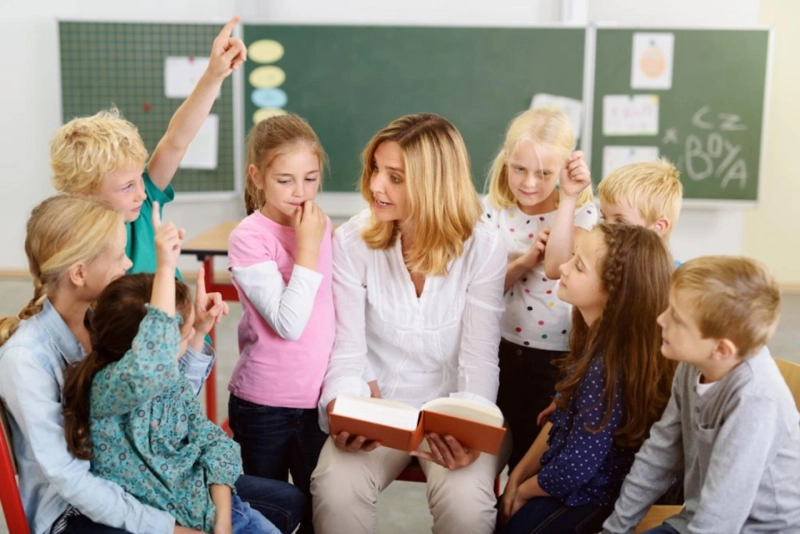In the course of studying the geometry of the basic school, tasks related to the practical application of the knowledge learned are considered: measuring work on the ground, measuring instruments. Practical work on the ground is one of the most active forms of communication between learning and life, theory with practice. Students learn to use reference books, apply the necessary formulas, master the practical techniques of geometric measurements and constructions.
Practical work in geometry lessons allows you to solve pedagogical problems: to pose students a cognitive mathematical problem, to update their knowledge and prepare for the assimilation of new material, to form practically skills and abilities in handling various devices, tools, computing equipment, reference books and tables .. They allow to implement in teaching the most important principles of the relationship between theory and practice: practice acts as an initial link in the development of theory and serves as the most important stimulus for its study by students, it is a means of testing theory and its area of application.
[caption class="snax-figure" align="aligncenter" width="1140"][/caption]
Practical work with the use of measuring instruments increases students' interest in mathematics, and solving problems on measuring the width of a river, the height of an object and determining the distance to an inaccessible point allow them to be applied in practice, to see the scale of application of mathematics in human life.
As you study the material, the ways of solving these problems change, the same problem can be solved in many ways. In this case, the following questions of geometry are used: equality and similarity of triangles, relations in a right triangle, the theorem of sines and the theorem of cosines, the Pythagorean theorem, properties of right triangles, etc.
Objectives of the lessons "Measurement on the ground":
practical application of theoretical knowledge of students;enhancing the cognitive activity of students;Tasks:
broadening the horizons of students;increasing interest in the subject;development of ingenuity, curiosity, logical and creative thinking;the formation of the qualities of thinking characteristic of mathematical activity and necessary for a productive life in society.When selecting the content of each lesson on a given topic and forms of student activity, the following principles are used:
the relationship between theory and practice;scientific character;visibility;taking into account the age and individual characteristics of students;combinations of collective and individual activities of the participants;differentiated approach;An example of practical knowledge can be: To build a right angle AOB on the ground with a given side OA, set a tripod with an ecker so that the plumb line is exactly above point O, and the direction of one bar coincides with the direction of the OA beam. The alignment of these directions can be accomplished with the help of a milestone placed on the beam. Then hang a straight line in the direction of the other bar (OB).
Criteria for assessing the achievement of the expected results:
student activity;students' independence in completing assignments;practical applications of mathematical knowledge;the level of creativity of the participants.Preparing and conducting such lessons allows, as a result:
connect, awaken and develop the potential abilities of students;to identify the most active and capable participants;to educate the moral qualities of a person: hard work, perseverance in achieving goals, responsibility and independence.teach to apply mathematical knowledge in everyday practical life.One of the most active forms of connection between learning and life, theory with practice, is the implementation by students in geometry lessons of practical work related to measurement, construction, and image. In the course of studying the geometry of the basic school, tasks related to the practical application of the knowledge learned are considered: measuring work on the ground, measuring instruments. In mathematics lessons, in parallel with the study of theoretical material, students should learn how to make measurements, use reference books and tables, and be fluent in drawing and measuring tools. The work is carried out both on the ground, and solving problems in the classroom in various ways to find the height of an object and determine the distance to an inaccessible point. According to the program in the course of geometry, the following questions are considered:
"Hanging a straight line on the ground""Measuring Instruments""Measuring angles on the ground""Building right angles on the ground"“Building tasks. Circle""Practical ways to build parallel lines""Corner reflector""Distance between parallel lines""Constructing a triangle from three elements"As a result of a series of lessons on the consideration of the practical application of geometry, students are convinced of the direct application of mathematics in the practical life of a person (measuring the distance to an inaccessible point, determining the height of an object in various ways by the end of basic school, using measuring devices). Solving problems of this type arouses the interest of students, who are eagerly awaiting lessons related to direct measurement on the ground. And the tasks proposed in the textbook introduce you to various ways of solving these problems.



